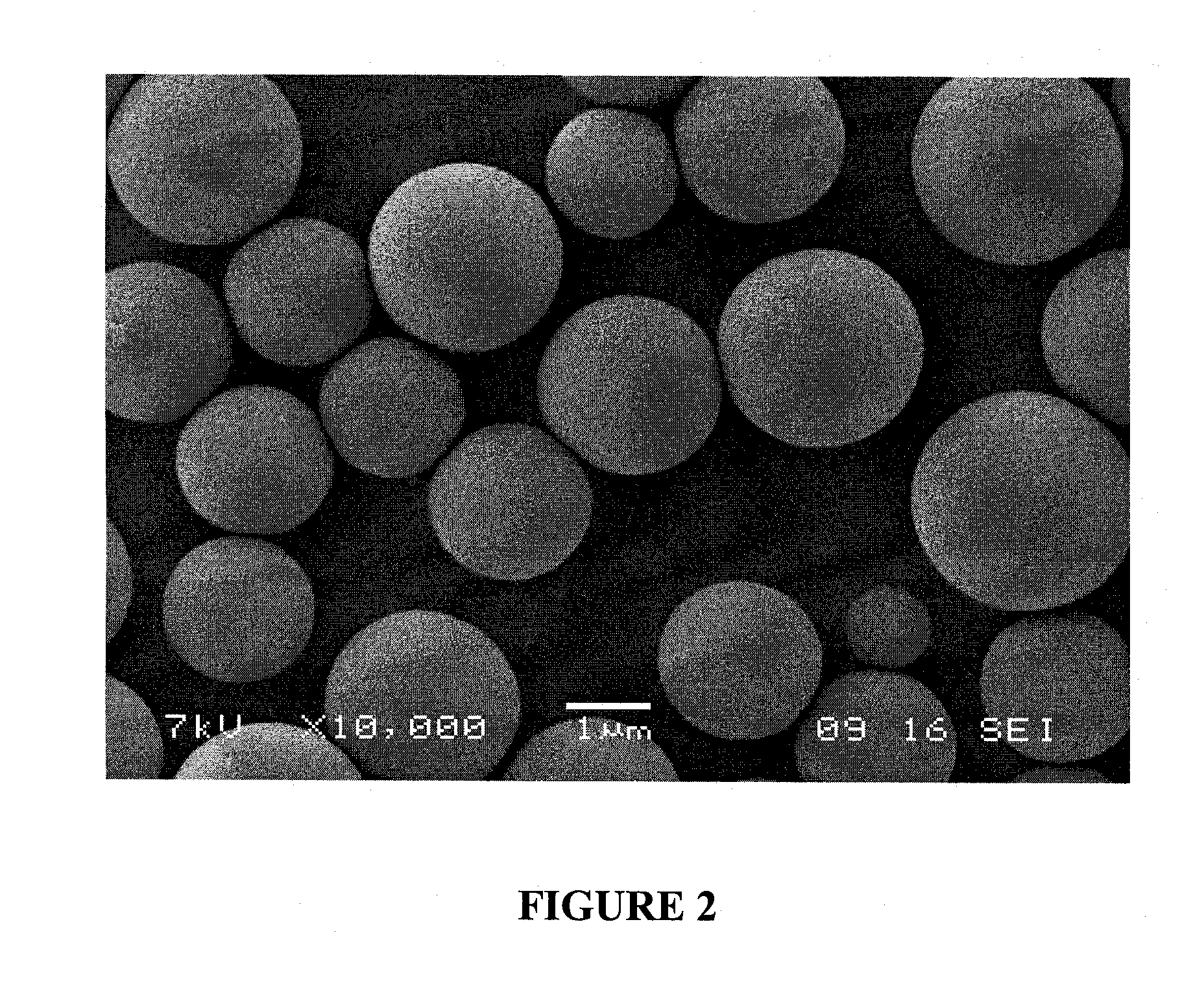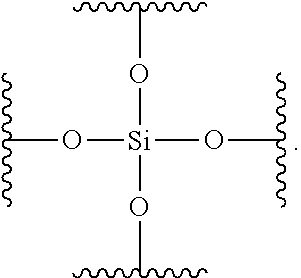Composite materials containing nanoparticles and their use in chromatography
- Summary
- Abstract
- Description
- Claims
- Application Information
AI Technical Summary
Benefits of technology
Problems solved by technology
Method used
Image
Examples
example 1
Synthesis of Polyorganosiloxanes
[0207]Following a process described by Jiang et al (U.S. Pat. No. 6,686,035 B2), one or more organoalkoxysilanes or tetraalkoxysilanes (all from Gelest Inc., Morrisville, Pa. or United Chemical Technologies, INC., Bristol, Pa.) were mixed with ethanol (EtOH, anhydrous, J. T. Baker, Phillipsburg, N.J.) in a round bottom flask. An aqueous solution 0.1 N hydrochloric acid (Aldrich, Milwaukee, Wis.) was added drop-wise into the flask. The resulting solution was agitated and refluxed for 16 hours in an atmosphere of argon or nitrogen. Alcohol was removed from the flask by distillation at atmospheric pressure.
[0208]Residual alcohol and volatile species were removed by heating at 95-120° C. for 1-2 hours in a sweeping stream of argon or nitrogen. The resulting polyorganoalkoxy siloxanes were clear viscous liquids. The chemical formulas are listed in Table 1 for the organoalkoxysilanes or tetraalkoxysilanes used to make a polyethoxylated siloxane polymer (POS...
example 2
Synthesis of Polyorganosiloxanes Containing Diamond Nanoparticles
[0209]Eight hundred and fifty five grams of a 4:1 molar ratio of tetraethoxysilane (TEOS, Gelest Inc., Morrisville, Pa.) and 1,2-bis(triethoxysilyl)ethane (BTEE, Gelest Inc., Morrisville, Pa.) were mixed with 415 grams of ethanol (EtOH, anhydrous, J. T. Baker, Phillipsburg, N.J.) in a round bottom flask. Ninety eight grams of an aqueous solution of 2 wt % diamond nanoparticles (Warren Superabrasives, Saint-Gobain Ceramic Materials, Olyphant, Pa., 5-50 nm) in 0.1 N hydrochloric acid (Aldrich, Milwaukee, Wis.) was prepared separately and was added drop-wise into the flask. The resulting solution was agitated and refluxed for 16 hours in an atmosphere of nitrogen. Alcohol was removed from the flask by distillation at atmospheric pressure. Residual alcohol and volatile species were removed by heating at 110° C. for 1 hour in a sweeping stream of nitrogen. The resulting polyorganoalkoxy siloxane (product 2a) was an opaque m...
example 3
Addition of Nanoparticles to Polyorganosiloxanes
[0210]Diamond nanoparticles (Nanostructured & Amorphous Materials, Inc, Houston, Tex., 4-25 nm), silicon carbide nanoparticles (Sigma-Aldrich, Saint Louis, Mo., <100 nm), or cubic boronitride (BN2600, LANDS Superabrasives, New York, N.Y., 125 nm) were added to a POS prepared in Example 1 that contained 0-15 wt % ethanol (EtOH, anhydrous, J. T. Baker, Phillipsburg, N.J.) or 0-61 wt % mesitylene (Mes; Aldrich, Milwaukee, Wis.), to yield a 0.08-1.00 wt % dispersion. For products 3a-3e the mixture was dispersed using a rotor / stator mixer (Mega Sheer, Charles Ross & Son Co., Hauppauge, N.Y.). For product 3f a sonic probe (Sonics & Materials, Inc., Newtown, Conn.) was used. All products were centrifuged (Thermo EXD, 4×1 L bottle centrifuge, Milford, Mass.) to reduce agglomerates. The resulting products with 0.08-0.62 wt % nanoparticle incorporation were opaque mixtures. Specific amounts are listed in Table 3 for the starting materials used t...
PUM
| Property | Measurement | Unit |
|---|---|---|
| Pressure | aaaaa | aaaaa |
| Percent by mass | aaaaa | aaaaa |
| Percent by mass | aaaaa | aaaaa |
Abstract
Description
Claims
Application Information
 Login to View More
Login to View More - R&D
- Intellectual Property
- Life Sciences
- Materials
- Tech Scout
- Unparalleled Data Quality
- Higher Quality Content
- 60% Fewer Hallucinations
Browse by: Latest US Patents, China's latest patents, Technical Efficacy Thesaurus, Application Domain, Technology Topic, Popular Technical Reports.
© 2025 PatSnap. All rights reserved.Legal|Privacy policy|Modern Slavery Act Transparency Statement|Sitemap|About US| Contact US: help@patsnap.com



